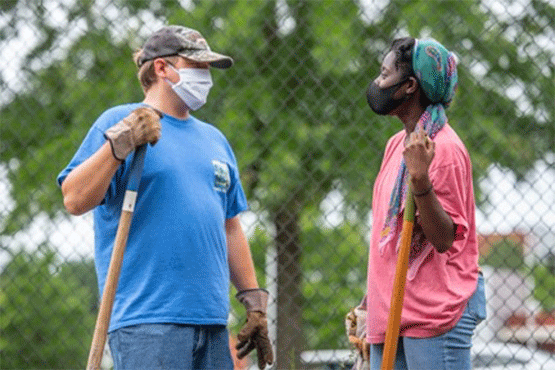news
Students, faculty pitch in to give Georgia Gwinnett College microfarm new life

More than two dozen students and faculty members gathered on a green, grassy plot of land in the center of Georgia Gwinnett College’s (GGC) campus Saturday, August 29 to bring life back to the school’s microfarm, which had gone neglected in the months since the COVID-19 pandemic forced the college to move to online instruction during the middle of the spring semester and to a hybrid format for fall semester. The volunteers rolled up their sleeves to pull weeds, clear debris, mow the tall grass and replant eight raised gardens that, if all goes well over the next few months, will overflow with fresh, healthy produce that will be donated to local families in need.
Nury Castro said the microfarm is a great volunteer opportunity for the campus community. As the assistant director of community engagement and service, Castro is the staff advisor of the Grizzlies Serve student program and said students enjoy giving back to the communities where they live and learn.
“The goal today is to clean up enough to start planting and growing again,” said Castro. “The microfarm has been a wonderful resource for our students. It gives them an opportunity to see first-hand all the things they discuss in the classroom like community service and being civically engaged, and shows them that even if you live in an urban or suburban area or a city you can live sustainably, grow your own food, give back and take care of the earth.”
The microfarm was the brainchild of professor of political science Paul Grant, who, along with a colleague proposed the concept to the college’s administration in 2012. Grant and a dedicated group of students have nurtured the garden which originally was established in 2013 on a 1,000 square-foot patch of ground just south of the “I” building.
The project was immediately embraced by the GGC community. A steady stream of professors and students from every school volunteered to overturn and cultivate the hard earth inch-by-inch until they had a 40 X 100 foot in-ground garden teaming with tomatoes, peppers, squash, zucchini and cucumbers in the spring and broccoli, kale, spinach, and other collards in the fall. Participants improved and expanded the garden each consecutive year until, in 2019, it was moved to its current larger, more centralized space just in time for the coronavirus pandemic to shut everything down.
Grant said the potential of the microfarm is now greater than ever, with 16,000 square feet to work with, so putting that land back to good use is a great way to start the new semester.
“This is a new beginning today,” he said. “Students will find this a wonderful opportunity to volunteer and do community service, right here on the campus, that’s really meaningful. During this time a lot of people have lost jobs and the number of people using food banks has really increased. Any food we can contribute will help now more than ever.”
The microfarm has proven to be the ultimate win-win for GGC and its surrounding community.
Over the years, it has yielded thousands of servings of fresh produce, which are harvested and donated to the Lawrenceville Cooperative Ministry. The rewards are perhaps even greater on the other side of the supply chain, where professors use the garden to teach everything from soil science and pollination to team-building and civic engagement, and students find a certain purpose and peace in the work.
“I just like putting seeds in soil and hoping something grows,” said Lois Iddrisu, a junior studying biochemistry who got involved in the microfarm her freshman year. “It relieves stress. School is tough, work is tough, but the ground . . . it’s just dirt, but it’s addictive.”
Brandon Seay, a senior majoring in environmental science, has been involved with the farm since the original groundbreaking in 2013.
“On one side, you do all the work here and you know why you’re doing it, but on the other side when you take the food to the food bank and see it going out to community members, giving them the choice to have fresh food rather than relying on canned and box goods, it’s just a great feeling,” he said. “It’s a fresh nutrient source, no chemicals, from people who had their heart in what they were doing.”
Plans for the new microfarm include expansions well beyond the eight raised gardens the volunteers cleaned and replanted during the event. An open-air greenhouse will be assembled in the near future, and 20 apple trees have been purchased that will be planted by students in January – the first step to a larger fruit orchard. Seay said they eventually hope to plant wildflowers around the perimeter to attract pollinators, and he hopes to see the garden used as a meeting and reflection space, complete with a pavilion.
“Growing food is kind of a spiritual thing,” said Grant. “It’s an absolute miracle to watch a small seed grow into a large plant that then produces this beautiful, healthy food.”
As the semester carries on, organizers hope the word spreads and more students get involved. Seay noted that, in the past, they’ve had 100 or more volunteers show up on a given day.
“I want people to know that we’re trying our hardest to make this something that the town of Lawrenceville and the community can hold dear,” said Iddrisu. “We want everyone to get involved. Whatever they can do to help, will help. Even if it’s just weeding with us on a Saturday, the reward is great.”
[data-ps-embed-type=slideshow] > iframe {position: absolute;top: 0;left: 0;}_psEmbed("https://ggc.photoshelter.com");
